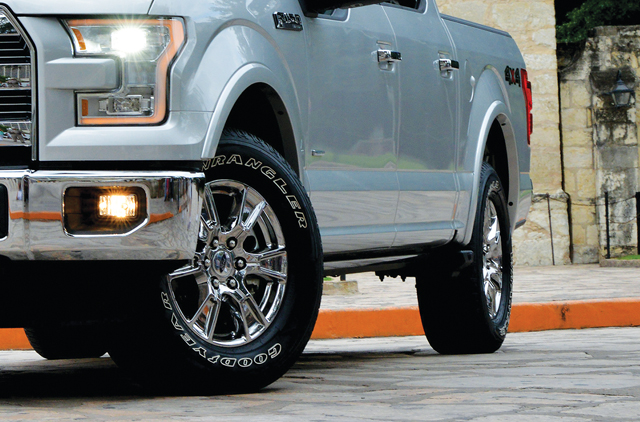MORE AND MORE AUTOMAKERS ARE TURNING TO ALUMINUM TO HELP MEET FUEL EFFICIENCY TARGETS

While others will be exploring the impact of aluminum in vehicles in this issue, I thought I would also try and touch on the issue from a couple of different angles.
You are probably aware that the new Ford F-150 has body panels and its bed made of aluminum.
According to Forbes, Ford derives $30 billion in revenue and 40 per cent of its profits from the best-selling vehicle in the U.S. The F-150 has long been the best-selling vehicle in Canada as well.
So for Ford, failure of the new aluminum-bodied F-150 is not an option.
Aluminum is but one of a myriad of different materials that are being incorporated into modern vehicles for one over-riding reason – fuel efficiency.
Two tranches of fuel efficiency standards have been introduced in North America, since 2011 in Canada and 2012 in the U.S.
The first set of regulations is in effect until 2016, and it requires automakers to achieve an average fuel economy rating of 35.5 miles per gallon. The second tranche of standards covers the period from 2017-2025, and requires an average fuel economy rating of 54.5 miles per gallon.
That seems like a tall order considering Dr. Michael Sivak and the University of Michigan Transportation Research Institute have noted that average fuel efficiency of vehicles purchased in the U.S. in 2014 was 25.3 miles per gallon.
Perhaps even more telling was that Dr. Sivak reports the fuel economy of vehicles purchased in April of this year actually went down from the 2014 average to 25.2 miles per gallon.
All of which underscores the fact that while manufacturers are regulated to meet certain fleet wide fuel efficiency standards, consumers are not limited in their ability to purchase whatever type of vehicle they desire – even if it happens to be a less fuel efficient option. That has tended to be the case over the last number of months of sustained lower gasoline prices.
However, whether the fuel efficiency targets that have been set by regulation are actually attainable is the subject of another article.
Because the regulators in the U.S. were unsure about fuel efficiency targets when the 2017-2025 regulations were developed, a mid-term review process was built into the regulations as a stock-taking exercise to assess the state of technological application and uptake in order for the vehicle manufacturers to meet the new standards.
As noted above, aluminum is not the only material being more widely used, as automakers apply the principles of light-weighting to achieve fuel efficiency gains.
How important is weight in the fuel economy equation? Well, consider that a 10 per cent reduction in vehicle mass can mean a fuel efficiency improvement of 6.5 per cent.
Reflecting on the new F-150 that is 700 lbs lighter than the vehicle it is replacing, fuel efficiency was touted to be from five per cent-29 per cent better than the previous F-150, depending on the choice of engine.
The new F-150 achieves a combined fuel economy rating that is about three miles per gallon better than the 2014 iteration.
Ford is not the only automaker using aluminum extensively. Traditionally aluminum has been more widely used in high-end vehicles owing to the fact that aluminum costs at least three times as much as steel.
Owing to the weight savings, more and more vehicle manufacturers will be incorporating aluminum into their vehicles as one way of reducing fuel consumption.
Ducker Worldwide LLC has estimated that by 2025, seven of 10 pickups will have aluminum bodies, and that percentage of aluminum in vehicles will double from 2008 to 2025. Aluminum will increase from 343 lbs per vehicle to 550 lbs per vehicle in 2025.
However, aluminum is just one material that is experiencing more extensive applications by automakers in an effort to shed weight from the vehicle.
Other materials being incorporated in higher volumes are magnesium, carbon fiber composites, titanium, glass fiber composites, as well as advanced high strength steel. As with aluminum, however, the cost compared to steel or cast iron can be anywhere from 1.5 to 10 times the cost.
BMW has been innovative in the use of its patented carbon fibre reinforced plastic (CFRP) in both its i3 electric and i8 plug-in hybrid electric vehicles to reduce weight and increase structural rigidity.
The increased structural rigidity provided by the CFRP obviated the need for the B pillar in the i3. However those two models are not the only ones benefitting from the CFRP. The 2016 BMW 7 series is slated to be 285 lbs lighter by virtue of higher utilization rates of aluminum combined with CFRP for its frame.
The challenge with using a variety of different materials in a vehicle’s frame and structure is not only the production complexity. With aluminum it is not easy to weld it and assembly often entails the use of rivets and adhesives.
Moreover, if you do not separate steel and aluminum where they join on a vehicle via adhesive or a plastic bushing of some sort, you will have a recipe for corrosion.
So while there are significant benefits associated with the migration to lighter weight materials to aid and abet fuel efficiency improvements it is clear that there are also many challenges.
The industry will no doubt overcome the challenges as more and more innovation is increasingly applied to the production, servicing and repair of modern vehicles.











